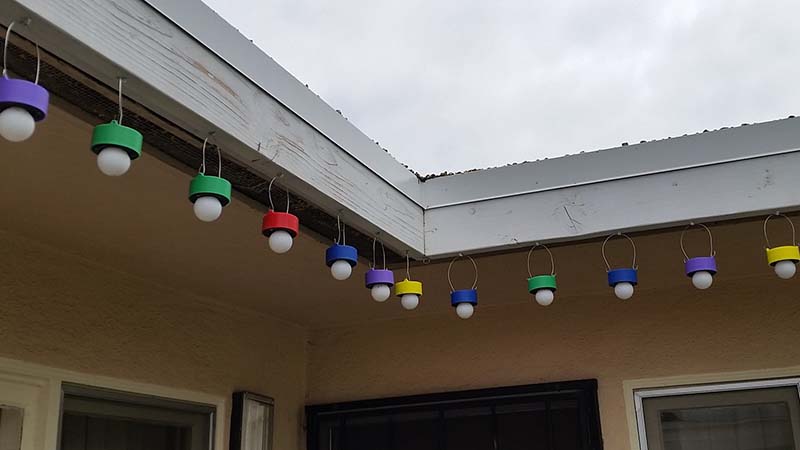White LEDs were the technological breakthrough that changed the world of lighting, now they are everywhere. There’s no better sign of their cost-effective ubiquity than the dollar store solar garden light: a complete unit integrating a white LED with its solar cell and battery storage. Not content with boring white lights on the ground, [Emily] decided to switch up their colors with a mix of single-color LEDs and dynamic color-changing LEDs, then hung them up high as colorful solar ornaments.
The heart of these solar devices is a YX8018 chip (or one of its competitors.) While the sun is shining, solar power is directed to charge up the battery. Once the solar cell stops producing power, presumably because the sun has gone down, the chip starts acting as a boost converter (“Joule thief”) pushing a single cell battery voltage up high enough to drive its white LED. Changing that LED over to a single color LED is pretty straightforward, but a color changing LED adds a bit of challenge. The boost converter deliver power in pulses that are too fast for human eyes to pick up but the time between power pulses is long enough to cause a color-changing circuit to reset itself and never get beyond its boot-up color.
 The hack to keep a color-changing LED’s cycle going is to add a capacitor to retain some charge between pulses, and a diode to prevent that charge from draining back into the rest of the circuit. A ping-pong ball serves as light diffuser, and the whole thing is hung up using a 3D-printed sheath which adds its own splash of color.
The hack to keep a color-changing LED’s cycle going is to add a capacitor to retain some charge between pulses, and a diode to prevent that charge from draining back into the rest of the circuit. A ping-pong ball serves as light diffuser, and the whole thing is hung up using a 3D-printed sheath which adds its own splash of color.
Solar garden lights are great basis for a cheap and easy introduction to electronics hacking. We’ve seen them turn into LED throwies, into a usable flashlight, or even to power an ATTiny microcontroller.
















The output of the choke is shorted to ground periodically by a transistor to charge it up. That’s why you need the diode, otherwise the capacitor would discharge through the boost transistor.
Yes, that’s how a boost converter works in general.
Other than waterproofing, are there any hacks to make these cheap solar lamps last longer?
e.g. larger capacitor?
I wonder if substituting the white LED for a yellow would use less battery and/or provide more brightness.
(Some of my oldest running solar LED lamps use yellow LEDs)
Probably the best way to improve the length of time they stay lit would be to put a better battery in them. The batteries that are included are usually of very poor quality.
Regarding the color, I’ve found that lights in which I installed green and blue LEDs stay on longer than the lights in which I installed yellow and red LEDs. The green and blue diodes have higher forward voltages, but I’m no EE, and I don’t know theory enough to know why that translates to a longer time staying on each night.
Higher FW voltage and very often much higher efficiency. So they run at lower current, but are still bright.
I guess the question is whether you adjusted things to maintain similar perceptual brightness, since the human eye is MUCH more sensitive to green than other colors and hence you need far less power to achieve the same visible brightness.
Thanks guys! (guys is not gender specific here)
I do have a bag of green LEDs that have been waiting to be used.
I just crammed new LEDs in without adjusting for anything.
I think you’re partially right that green just seems brighter than red, but really the red and yellow ones do die hours before the blue and green ones. Sometimes the blue and green ones will still have some charge left when morning comes, whereas the red and yellow ones are often dead by midnight.
I just crammed new LEDs in without adjusting for anything.
I think you’re partially right that green just seems brighter than red, but really the red and yellow ones do die hours before the blue and green ones. Sometimes the blue and green ones will still have some charge left when morning comes, whereas the red and yellow ones are often dead by midnight.
In Oz you can buy color changing garden solar lights for ~$1. Bought some for Christmas and they are still going strong.
Nice, they still go for 3 for $10 here in the U.S.
File this one away because the temptation to convert cheap solar lights to *stuff* will pop up eventually for a lot of people, and likely more and more as electronics dive for lower voltages and current needs.
I did this to change some garden lights to flame-flicker rather than steady lights. Since the flicker lights have their own µprocessor (as do the RGB), I had to blunder around with the diode/cap dance that is shown here.
I’d like to see the circuit/die of that uproc in the color changing LEDs.
This has proven as very informative indeed!
Thanks a lot! jayFour